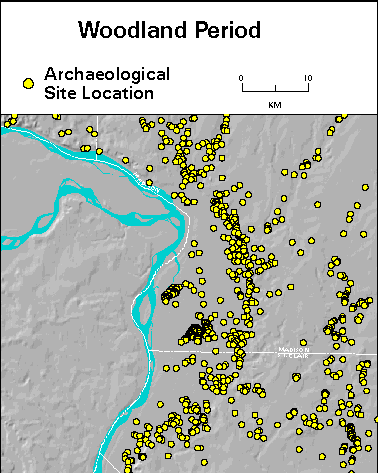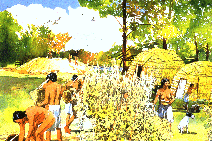Woodland Settlement

A Meeting By the River
Woodland peoples of the American Bottom continued the Late Archaic trend of establishing longer-term settlements in the river valley. Areas in the valley floor with some dry land for gardens, and wetlands for gathering, fishing, and hunting wetland resources became the focus of Woodland residences and activities for their increasingly numerous and populous villages. One hallmark of the Woodland economy and settlement system was the growing importance of small, seasonally occupied and highly specialized, short-term camps for the harvesting of special resources like deer, chert, nuts and berries, and other items not found near the permanent villages.
 By the end of this period Native Americans were living continuously for multiple years in villages up and down the river valleys of the midwest. On adjacent blufftops mounds were constructed for the burial of the dead. These mounds may have functioned as cultural markers like the flags of nations today signify the land of a particular people. Subtle differences in tool styles and pottery decorations may reflect the same cultural differences among Woodland peoples.
By the end of this period Native Americans were living continuously for multiple years in villages up and down the river valleys of the midwest. On adjacent blufftops mounds were constructed for the burial of the dead. These mounds may have functioned as cultural markers like the flags of nations today signify the land of a particular people. Subtle differences in tool styles and pottery decorations may reflect the same cultural differences among Woodland peoples.
By the end of this period many cultural features such as pottery style, arrow point styles, and mounds defined different Woodland cultures in well-defined areas of the midwestern Central States.
 By the end of this period Native Americans were living continuously for multiple years in villages up and down the river valleys of the midwest. On adjacent blufftops mounds were constructed for the burial of the dead. These mounds may have functioned as cultural markers like the flags of nations today signify the land of a particular people. Subtle differences in tool styles and pottery decorations may reflect the same cultural differences among Woodland peoples.
By the end of this period Native Americans were living continuously for multiple years in villages up and down the river valleys of the midwest. On adjacent blufftops mounds were constructed for the burial of the dead. These mounds may have functioned as cultural markers like the flags of nations today signify the land of a particular people. Subtle differences in tool styles and pottery decorations may reflect the same cultural differences among Woodland peoples.
